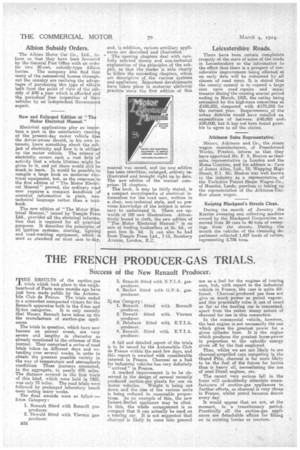THE FRENCH PRODUCER-GAS TRIALS.
Page 8

If you've noticed an error in this article please click here to report it so we can fix it.
Success of the New Renault Producer..
TlIE RESULTS of the suction-gas trials which took place in the neighbourhood of Paris some months ago have just been made public by the Automobile Club de France. The trials ended in a somewhat unexpected victory for the Renault apparatus both in the 5-ton and
3L-ton categories. It is only recently that Messrs. Renault have taken up the the manufacture of suction-gas appliances.
The trials in question, which have now become an annual event, are very severe and lengthy in character as already mentioned in the columns of this journal. They comprised a series of road trials taken on different days and extending over several weeks, in order to obtain the greatest possible variety in the way of temperature and atmospheric conditions. These journeys amounted, in the aggregate, to nearly 870 miles. The distance covered in the first trials of this kind, which were held in 1922, was only 75 miles. The road trials were followed by prolonged laboratory bench tests lasting many weeks.
The final awards were as follow:5-ton Category: 1. Renault fitted with Renault gasproducer.
2. Dewald fitted with Vierzon gasproducer. B24 • 3. Renault fitted with E.T.I.A. gasproducer.
4. Berliet fitted with G.P.A. gas. producer.
31-ton Category : 1. Renault fitted with Renault producer.
2. Dewald fitted with Vierzon producer, 3. Delahaye fitted with E.T.I.A. producer.
4. Renault fitted with E.T.I.A. producer.
A full and detailed report of the trials is to be issued by the Automobile Club de France within the next few days, and this report is awaited with considerable interest in France. Charcoal as a fuel for industrial vehicles has very definitely "arrived" in France.
A marked improvement is to be observed in the design of several recently produced suction-gas plants for use on motor vehicles. Weight is being cub down and the size of the various units is being reduced to reasonable proportions. As an example of this, the new Imbert-Berliet appliance may be cited. In this, the whole arrangement is so compact that it can actually be used on a touring car. It is not suggested that charcoal is likely to come into general
use as a fuel for the engines of touring cars, but, with regard to the industrial vehicle in France, the case is quite different. Charcoal-produced gas does not give so much power as petrol vapour, and this practically rules it out of court so far as the touring car is concerned, apart from the rather messy nature of charcoal for use in this connection.
In the commercial vehicle, however, the best engine is not necessarily the one which gives the greatest power for a given cylinder bore. It is the engine which produces the greatest horse-power in proportion to the calorific energy given off by the fuel employed.
Thus, whilst we are not likely to see charcoal-propelled cars competing in the Grand Prix charcoal is far more likely to be the fuel of the future for lorries than is heavy oil, necessitating the use of semi-Diesel engines, etc.
The recent very serious fall in the franc will undoubtedly stimulate manufacturers of suction-gas appliances to farther efforts, as charcoal is very cheap in France, whilst petrol becomes dearer every day. It would appear that we are, at the moment, in a transitionary period. Practically all the suction-gas appliances are detachable affairs for Ming on to existing lorries or tractors.






























